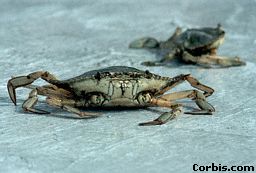

 Chionoecetes opilio, or
snow crab, belongs to the phylum Arthropoda, class Crustacea, and order Decapoda. Crabs
have broad, flattened bodies which are covered by a hard shell, and grow by moulting their
shell. (Grolier Multimedia Encyclopedia, 1993.) Chionoecetes opilio lives in deep
sea water at low temperatures. (Halcrow and Steel, 1991.)
Chionoecetes opilio, or
snow crab, belongs to the phylum Arthropoda, class Crustacea, and order Decapoda. Crabs
have broad, flattened bodies which are covered by a hard shell, and grow by moulting their
shell. (Grolier Multimedia Encyclopedia, 1993.) Chionoecetes opilio lives in deep
sea water at low temperatures. (Halcrow and Steel, 1991.)
Halcrow and Steel (1991) studied cuticular repair in mature male Chionoecetes opilio. It is believed that after male Chionoecetes opilio become mature, they no longer possess functioning Y-organs, which provide the hormone that causes moulting. During moulting in immature Chionoecetes opilio, the secreted hormone causes cuticle to be produced to replace the cuticular surface which has been moulted, or to replace damaged cuticle. The experimenters wished to assess the ability of mature male Chionoecetes opilio to repair damage, since they apparently do not possess functioning Y-organs.
The experimenters obtained male Chionoecetes opilio, determined their maturity, then took hemolymph (circulating fluid) samples. In one group of Chionoecetes opilio, wounds were given by drilling partially or completely through the dorsal (back) surface of the cephalothorax (head and thorax) or a limb. Controls specimens were not wounded. Tissue samples and hemolymph samples were taken at intervals. In the second group of Chionoecetes opilio, a wound was given through the cuticle and epidermis, causing the Chionoecetes opilio to amputate an appendage. Tissue and fluid samples were taken at intervals.
In the first group of Chionoecetes opilio, the repair material was produced at the wound. They had very low concentrations of the moulting hormone. In the second group, clotted hemolymph plugged the wound, then a layer of cuticle was produced. The cuticle in the immature and mature Chionoecetes opilio did not seem to be different. The levels of hormone in the second group did not change consistently over time, and the concentrations were generally low.
The experimenters concluded that mature male Chionoecetes opilio do have the moulting hormone in their circulating fluid. If it is true that the Y-organs in Chionoecetes opilio do not function after maturity, then the moulting hormones, the ecdysteroids, must come from another source.
REFERENCES
1993. Grolier Multimedia Encyclopedia. Crab. Grolier Electronic Publishing, Inc.
Halcrow, K. and Steel, C. G. H., 1991. Cuticular repair in the mature male snow crab, Chionoecetes opilio. Canadian Journal of Zoology, 70: 314-319.
September 1997
Related books for sale on Amazon.com:
Grolier Multimedia Encyclopedia (CD-ROM)
Bibliography of Research on Snow Crab: Chionoecetes Opilio by A. J. Paul
| Home | Chemistry | Physics | Astronomy | Biology | Ecology |
| Geography | Medicine | Mathematics | Technology |
| Issues | Scientists | General | Reference |
Last Updated Sunday, August 26, 2007 21:07 -0400
� Suzanne P. Currie 1999 [email protected]